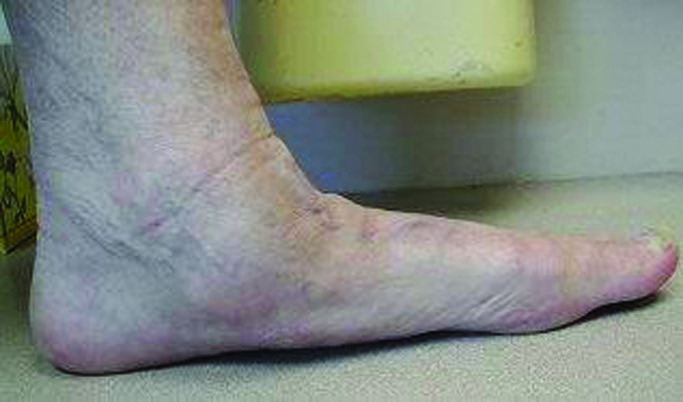ADVERTISEMENT
Podiatry VA Parity Bill Passes Congress
 After a long legislative gestation, a bill ensuring podiatric physician parity in the Veterans Health Administration (VA) system was recently passed by Congress.
After a long legislative gestation, a bill ensuring podiatric physician parity in the Veterans Health Administration (VA) system was recently passed by Congress.
The House and Senate recently approved the VA Provider Equity Act as part of the John S. McCain III, Daniel K. Akaka, and Samuel R. Johnson VA Maintaining Systems and Strengthening Integrated Outside Networks Act (MISSION) Act. The act will update the status of podiatrists in the VA system for the first time since 1976, according to American Podiatric Medical Association (APMA) President Dennis R. Frisch, DPM. President Trump signed the act into law in June.
“Our profession—our education, training and experience—has changed dramatically in the past 42 years and the provisions in APMA’s VA Provider Equity Act, passed as part of the MISSION Act, reflect those changes,” says Dr. Frisch. “Podiatrists within the VA will now be part of the same pay band as their allopathic and osteopathic colleagues. They will have access to new leadership opportunities.”
The VA MISSION Act puts podiatric physicians on par with their allopathic and osteopathic colleagues in regard to salary and opportunity for advancement in the VA healthcare system, agrees Patrick DeHeer, the Chair of the APMA Legislative Committee and member of the APMA Board of Trustees. He notes that parity is “a significant recruitment and retention tool for the VA healthcare system to fill a significant need.” Dr. Frisch adds that with the act’s passage, the VA can retain physicians who train in VA residency programs and also hire “outstanding physicians” from the private sector.
Veterans will get “expedient access to needed foot and ankle care from highly trained and experienced podiatrists,” notes Dr. Frisch. He points out that it can take more than a year for the VA to recruit a podiatrist to fill a vacant position, which means veterans’ wait times can be up to several months for lower extremity care, forcing these patients to seek care outside the VA. Such increased healthcare access is critical for veterans who have diabetes, as Dr. DeHeer notes preventative care and therapeutic care of the foot are critical to reduce the risk of amputations in the diabetic population.
Drs. Frisch and DeHeer call the passage of the MISSION Act historic for podiatry, noting the act will also have an impact on parity in all levels of federal legislation. Dr. Frisch notes that the APMA has lobbied for seven years to ensure provider equity at the VA and that the APMA will continue to address reimbursement and recognition for podiatrists in the private sector via active health policy advocacy efforts. Dr. DeHeer adds that the APMA will turn its legislative focus toward updating Title XIX, which governs Medicaid.
“Thanks to the members who lobbied for this legislation, contributed to the American Podiatric Medical Association Political Action Committee (APMAPAC) and educated their legislators, America’s heroes will have faster, better access to high-quality foot and ankle care provided by podiatrists,” says Dr. Frisch.
For further reading, see Dr. DeHeer’s DPM Blog “Applauding The APMA And Those Who Worked To Pass The VA Provider Equity Act” at https://tinyurl.com/ycy5ozmy.
Study Examines Flatfoot Surgery Outcomes In Older Patients
By Brian McCurdy, Managing Editor
 A recent study in Foot and Ankle International noted that older patients with stage II flatfoot had rates of revision surgery after surgical reconstruction that were comparable to outcomes of younger patients.
A recent study in Foot and Ankle International noted that older patients with stage II flatfoot had rates of revision surgery after surgical reconstruction that were comparable to outcomes of younger patients.
The study focused on 140 consecutive feet with stage II adult-acquired flatfoot deformity in 137 patients. After two years, researchers found the 32 patients over age 65 had no differences in changes in Foot and Ankle Outcome Scores (FAOS) in comparison with younger and middle-aged patients. The authors noted that following flatfoot reconstruction, older patients had significant postoperative improvements in all FAOS subgroups such as pain and quality of life.
Doug Richie Jr., DPM, FACFAS, agrees with the authors’ chosen surgical procedures for older patients with flatfoot. Specifically, he says calcaneal osteotomies combined with medial column stabilization work well for all patients with stage II adult-acquired flatfoot but notes that one should avoid hindfoot fusions in older patients.
Dr. Richie points out that the authors favor a first metatarsal-medial cuneiform fusion while he has had good results with a naviculocuneiform fusion. He has not used a flexor digitorum longus transfer over the past five years although the authors note this is a mainstay treatment for older patients. In contrast, Dr. Richie has been using the InternalBrace (Arthrex) spring ligament augmentation and cites “very good results.”
“I have always had better outcomes with adult-acquired flatfoot surgery on older patients compared to younger patients,” says Dr. Richie, an Adjunct Associate Professor within the Department of Applied Biomechanics at the California School of Podiatric Medicine at Samuel Merritt University in Oakland, Calif.
Dr. Richie cites adherence as a factor in the success of flatfoot surgery in seniors, noting that older patients are more adherent than younger patients. He adds that adherence overrides the concerns about flatfoot surgery risks with older patients such as blood flow and bone quality. As Dr. Richie notes, the study required patients to be non-weightbearing for eight weeks with subsequent use of an immobilizer boot for four more weeks.
“Younger patients tend to break the rules more often than older patients,” says Dr. Richie.
Bone quality is a concern with flatfoot surgery, Dr. Richie says, particularly with older women, who are more likely to have flatfoot in comparison to male patients. Fall risk is also an issue and he notes non-weightbearing ambulation “is a formidable challenge for all patients.” As Dr. Richie says, older patients may lack the strength to ambulate without crutches while immobilizing devices compromise balance and increase fall risk.
Dr. Richie also cites a difference in the living conditions and availability for assistance in older and younger patients. He notes older patients often live alone and do not have assistance while younger patients may have a spouse or relative nearby to provide help in the home setting during the first few critical weeks of postoperative recovery.
How Effective Is Topical Oxygen In Healing Wounds?
By Brian McCurdy, Managing Editor
Topical oxygen can be a valuable adjunct to help heal chronic wounds, according to an abstract presented at the recent European Wound Management Association conference.
The two-year retrospective review focused on 115 wounds in 71 patients who received topical oxygen. Researchers noted the most common wounds in the study were those involving venous/lymphatic insufficiency, trauma and diabetes. The study notes that 64.4 percent of 115 wounds closed in two years with the authors noting the results improved on their wound closure results of 44 and 56 percent in previous studies. The study authors add that the majority of open ulcerations in the study had concurrent treatment with advanced tissue products and venous or arterial pumps because of patients’ comorbidities.
Khurram Khan, DPM, cites several advantages of topical oxygen over hyperbaric oxygen, including ease of use in the patient’s home and minimal requirements for nursing or home visits.
Dr. Khan notes the disadvantages of topical oxygen include safety issues, such as forbidding open flames and smoking during the therapy’s use. One must also educate patients on the correct use of topical oxygen and there is no way to know if the patient is adherent, according to Dr. Khan, an Associate Professor in the Department of Podiatric Medicine at the Temple University School of Podiatric Medicine.
However, Dr. Khan cautions there is no good evidence-based medicine to recommend topical oxygen. He notes that in the abstract, the topical oxygen was an adjunct treatment without a control arm and questions how topical oxygen would perform in comparison to other treatment modalities.











